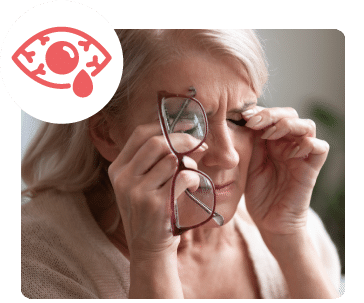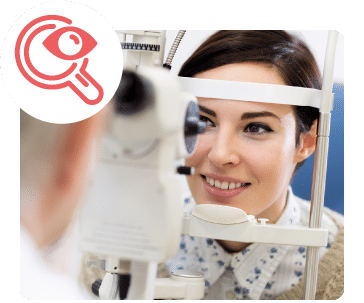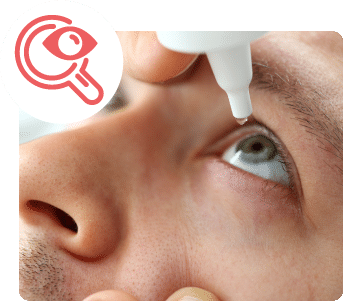Tear Lab Evaluation and Dry Eye Treatment
Are you tired of searching for relief from dry eyes? Look no further, our office has solutions for you!

“I have dry eyes” has become a daily complaint in Optometry clinics like ours. Dry eyes can be from a variety of sources. Sometimes a person’s eyes are dry because of environmental issues, like our dry Calgary climate. They can also be caused by prolonged computer use or incomplete/infrequent blinking. Dry eye also has several overall health links, including arthritis, diabetes, allergies, and medication side effect. People over the age of 45 are more likely to suffer from eye dryness, and women are more likely to experience it than their male counterparts.
Dry eyes can be caused by a deficiency in aqueous (wet) tear production or oily tear production. Solving the cause and identifying the solution for dry eyes is a real puzzle. That’s why we are Modernizing our approach at the Glenmore Landing Vision Center. We are happy to announce the addition of new dry eye diagnostic tools along with dry eye treatment options to our clinic.
The Modern Approach to managing dry eyes has 3 steps:

Step 1 – Specific symptom identification

We start by offering dry eye questionnaires to all our full adult exams. We send out the OSDI and SPEED questionnaires, which are peer-reviewed and medically accepted. Depending on the results of these questionnaires we may recommend raising to step 2.
Step 2 – Key medical sign investigation with routine care

Step 2 specifically involves testing tear film osmolarity (saltiness of tears) as well as fluorescein ocular surface staining and measuring the tear breakup time. Tear osmolarity has become a focus of dry eye diagnosis and management. In fact, according to the DEWS II dry eye study (the current cutting-edge medical review for dry eye), tear film osmolarity and inflammation actually cause the symptoms of dry eye and cause damage to the ocular surface in Dry Eye Disease. Fluorescein staining and tear breakup time help determine if the dry eye is more likely to be due to a problem in the aqueous or oil layer of the tears.
Step 3 – Expansive dry eye testing and follow up

Sometimes these basic assessments are not enough. If more investigation is needed, or the eye dryness is severe enough, we will elevate to step 3. In these cases, we will recommend a Gold Standard Dry Eye assessment. At the Glenmore Landing Center, we are partnered with the Clarity Seema Institute. The Clarity Seema Institute is the leader of advanced dry eye assessment and care lead by the celebrated ophthalmologist Dr. Ahmed Al-Ghoul. At the Glenmore Landing Vision Center, our gold standard assessment is based on the procedures and recommendations of Dr. Al-Ghoul and includes assessments of tear osmolarity, Partial blink frequency, Meibography, Corneal sensation, Floppy Eyelid grading, Lagophthalmos, Lid Redness, Lid Collarettes, Lid Telangiectasia, Conjunctival achalasia, TBUT (Invasive), Staining pattern, Staining amount (qualitative), MG secretion quality, and MG expressibility.

Our Technology – TearLab And Meibography

TearLab
Dry eye is a multifactorial disease of the tears and ocular surface that results in symptoms of discomfort, visual disturbance, and tear film instability with potential damage to the ocular surface. It is accompanied by increased osmolarity (concentration of salt) of the tear film and inflammation of the ocular surface.
The TearLab Osmolarity System* is intended to measure the osmolarity of human tears to aid in the diagnosis of dry eye disease in patients suspected of having dry eye disease, in conjunction with other methods of clinical evaluation.
We now have TearLab available at the Glenmore Landing Vision Center. It is a quick and painless test that collects a small quantity of your tears and analyzes it. The result of this test is an important piece to the puzzle of whether you have dry eye, how severe it is, and how to manage it.
For more information, you can visit the TearLab website, HERE.
Meibography
Our tears are a complex fluid. They are composed of water, proteins, mucins, salts, and oil. Without all of these components, our tears don’t function properly, and the surface of our eyes suffers.
A common way our tears get compromised is low levels of oil. Our tears get oil from our Meibomian Glands, which are long thin glands in our eyelids. If the Meibomian Glands are compromised, our tears become unstable and evaporate too quickly.
Meibography is when we use infrared light to take pictures of the Meibomian Glands and analyze them. Meibomian Gland’s health is an important piece to the dry eye puzzle.
At the Glenmore Landing Vision Center, we now have an infrared camera mounted to our slit lamp and software that helps analyze the pictures. Understanding your Meibomian Gland health is now just a camera flash away.


